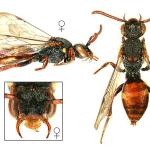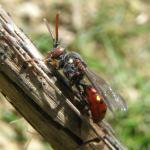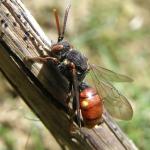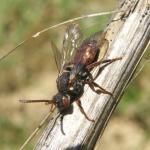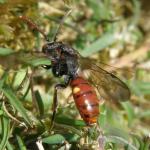Apis montana SCOPOLI 1763; Nomada ruficornis SCOPOLI 1770 (nec. L.); Apis minor GMELIN 1790; Apis xanthosticta KIRBY 1802; Nomada lateralis PANZER 1804; Nomada bridgmaniana SMITH 1876; Nomada lateralis var. blancoburgensis SCHM. 1882; Nomada lateralis var. megapolitana SCHM. 1882
This species is commonly listed under the name Nomada xanthosticta (Kirby, 1802) in the British literature (the species name is now treated as a junior synonym of Nomada ferruginata (Linnaeus, 1767)).
A rare species, but formerly widely distributed in southern Britain. There were no records between 1949 and 1987. However, in recent years the species has undergone a resurgence, with confirmed records from Hampshire, Kent, Wiltshire, Berkshire, Middlesex, Gloucestershire, Warwickshire, Essex and Suffolk. This is a northern and central European species, becoming more sparsely distributed in the south.
Listed as Endangered (RDB1) in the British Red Data Book (Shirt 1987) and by Falk (1991). Recent data suggests this status needs revision
Sites include open deciduous woodland, the coast (as at Dungeness, east Kent) and open sites where the host species occurs.
Univoltine; mid April (exceptionally March) to mid May.
A cleptoparasite of the mining bee Andrena praecox (Perkins 1919; Chambers 1949; Westrich 1989). It is only found with a small number of populations of this host species. Chambers (1949) also lists Andrena varians as a possible host.
Lesser celandine (Ranunculus ficaria), black currant (Ribes nigrum), sallow (Salix sp.) and dandelion (Taraxacum sp.).
No information available.
Profile written:
Updated: 05/10/2012


